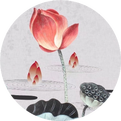Yang deficiency manifests in numerous symptoms, making it difficult to list them all. To provide a clearer and more intuitive impression, we will simply enumerate 100 common symptoms for reference. Score one point for each symptom you identify; how many points can you accumulate? 1. Pale complexion, pale lips, pale eyelids, and excessive clear saliva. 2. Dull complexion, dark and lackluster skin; darkened area between the eyebrows and facial swelling. 3. Lack of thirst, prefers warm drinks. 4. Tongue is pale red or pale white, swollen with teeth marks on the edges, white and slippery coating; thick and greasy coating. 5. Yellow and greasy coating, but slippery; tongue body is weak and pale. 6. Pulse is thin, weak, slow, and rough; may be rapid but weak, floating and scattered, or hollow, etc. 7. Cyanotic and dark facial color. Dull yellowish complexion. 8. Excessive facial oiliness, noticeable dirt, leading to skin lesions in multiple areas. 9. Dark, purple lips, dry and cracked, but without obvious heat signs. 10. Frequent acne, but without significant redness, swelling, or pain. Recurs often, usually as single lesions, especially around the mouth and jaw. 11. Frequent subcutaneous lumps or nodules, painful upon pressure, but no obvious protrusions or redness on the surface. 12. Dark circles under the eyes, eyelids swollen upon waking. 13. Pale gums, or frequent bleeding. 14. Sparse, yellow, and dry hair. Frequent hair loss. 15. Hair becomes oily easily. Oily the day after washing, but without a strong odor. 16. Frequent headaches and dizziness. 17. Sudden dizziness upon getting up, prolonged squatting or standing, or after intense exercise. 18. Frequent colds. Symptoms include fear of cold, fear of wind, nasal congestion, clear nasal discharge, cough, lack of thirst, clear and thin phlegm, spontaneous sweating. 19. Allergic rhinitis. Symptoms similar to the previous point. Sneezing continuously upon waking every morning. Symptoms may improve slightly after eating and moving. Severe cases may not see improvement. 20. Facial spots, various pigmentation, freckles, and ringworm. Frequent lipomas and papillomas. 21. Frequent oral ulcers, recurring. Wounds appear white or light red, with no significant swelling. 22. Dry mouth, purple tongue, but prefers to rinse with water rather than swallow. 23. Chronic pharyngitis and laryngitis, recurring. No significant fever during episodes. 24. Frequent facial paralysis, stiff neck, etc. Neck pain, especially at the back, pulling pain at the back of the head. 25. Frequent shoulder pain, worsened by wind or cold. 26. Nodules or hard lumps can be felt in the back and shoulders, with significant pain upon pressure. 27. Obesity with weak, pale muscles, lack of strength, and fatigue. 28. Prone to chest tightness, especially in cold conditions. Back feels icy, about the size of a palm, more common in older individuals. 29. Shortness of breath, chest tightness, labored breathing, and weak wheezing. Pressure feels comfortable. 30. Rapid or slow heartbeat, but pulse is weak. 31. Soreness in the back, lower back, and knees, worsened by cold. 32. Excessive oiliness on the back, frequent acne, and persistent non-healing. 33. Poor appetite, picky eating, prone to bloating, stomach pain, acid reflux, vomiting, etc. 34. Very small food intake. Or large intake but prone to diarrhea, stomach pain, and bloating. 35. Eating cold foods like raw fruits or drinking cold beverages easily leads to diarrhea and stomach discomfort. 36. Frequently drinking cold water and eating cold food, regardless of season. But without significant diarrhea or gastrointestinal discomfort. Cold pathogens can affect other organs, leading to phlegm, obesity, dark complexion, swelling, lower back and knee pain, varicose veins, etc. 37. Liver and spleen enlargement, ascites, cholecystitis, stones, various digestive and urinary diseases, presenting with fatigue, cold intolerance, and lack of heat signs. 38. Irregular menstruation, including excessive, insufficient, early, delayed, prolonged, or short periods, but with thin, pale, or dark blood with clots. 39. Frequent dysmenorrhea, with acute, dull, severe, hidden, distending, or stabbing pain. 40. Amenorrhea is very common, leading to infertility. 41. Frequent metrorrhagia. Generally, more bleeding occurs, including prolonged menstruation and intermenstrual bleeding. Metrorrhagia is secondary but still significant. 42. Menstruation occurs every two to three months, consistently. Menstrual blood is either thin, dark, or with clots. 43. Increased vaginal discharge, clear and thin, or thick and foul-smelling, or mixed colors, filthy and foul-smelling. 44. Various discomforts during menstruation, including headaches, dizziness, nausea, vomiting, chest tightness, bloating, diarrhea, constipation, fatigue, poor appetite, frequent colds, easy to get heat, easy gum bleeding, purpura, extreme emotional instability, cold pain in the lower abdomen, cold hands and feet, temporary deafness or tinnitus, or exacerbation of existing symptoms. 45. Normal sexual life, intending to conceive but experiencing long-term infertility without obvious discomfort, consider that one or both partners may be “cold beauties.” 46. Pregnant women with extreme pregnancy reactions, severe morning sickness, primarily consider the woman as a cold beauty. 47. Pregnant women without other obvious discomfort or external influences, experiencing multiple miscarriages or habitual abortion. 48. During pregnancy, significant fatigue, loss of appetite, anemia, edema, palpitations, insomnia, constipation, diarrhea, cold intolerance, swollen eyelids, gum bleeding, athlete’s foot, and worsening skin conditions. 49. Insufficient milk supply during breastfeeding, or thin milk. Prolonged weaning period, unable to stop milk production. 50. Long after weaning, even years later, still producing milk, with scant menstruation or other menstrual irregularities. 51. Insufficient breast development, early sagging, and atrophy. 52. Mammary gland hyperplasia, nodules, etc., but with fatigue and lack of heat signs. 53. Uterine fibroids, ovarian cysts, etc., presenting with poor appetite, fatigue, and pale complexion with weak pulse. 54. Uterine prolapse, vaginal prolapse, gastric prolapse, and other significant prolapse symptoms. 55. Female sexual desire is low, or arousal is slow, or rarely experiences orgasm. 56. Male impotence, premature ejaculation, weak erection. No morning erection. 57. Significant fatigue after sexual activity, insomnia, lack of energy the next day, or excessive excitement, prone to colds or diarrhea, etc. 58. Frequent nocturnal emissions, even daily. Semen is thin and watery. 59. Moist and cold scrotum. Skin has inflammatory lesions, ringworm, or skin growths. 60. Abdominal obesity, leg obesity, lower limb obesity or edema, with pitting upon pressure. 61. Frequent urination, pale urine, or increased frequency, or incontinence, or incomplete urination, or cloudy urine, etc. When going out, one focuses on public restrooms, entering one after another, essentially acting as a health inspector. 62. Soft stools, three to five times a day, or even more than ten times. 63. Watery stools, undigested food; or sticky, foul-smelling; using multiple pieces of toilet paper, always unable to clean properly. 64. Frequent constipation, not having a bowel movement for three to five days, but without significant pain. Stools are hard at first, then must be loose. Although hard, they are not foul-smelling, or slightly fishy. 65. Urine may be yellow, but no burning or painful sensation in the urethra. Stools may be hard, but no burning sensation in the anus. 66. Hemorrhoids recur, but bleeding is slightly dark, and stools are not burning. 67. Persistent moisture around the anus. Persistent cold and damp feeling in the vulva. 68. Itching in the genital area, dampness. Inflammatory ulcerative lesions, or various growths, white or slightly red and swollen. 69. Cold hands and feet, even cold feet above the knees, cold hands above the elbows. Worse in summer, more severe in winter. 70. On rainy days or in cooler temperatures, hands and feet feel numb and swollen. 71. Prone to athlete’s foot, foot rot, and other conditions in summer. 72. Excessively dry feet, rough skin, even cracking, especially in winter. 73. Feeling a chill rising from the feet, spreading upwards. Prone to frostbite in winter. 74. Palms sweat easily, peeling, blistering, ulcerating, etc. 75. Cracked palms, bleeding, peeling, with a red color. But without significant heat signs, even with obvious deficiency of qi and blood. 76. Hot hands and feet, especially at night, must extend them outside the covers to sleep, even feeling anxious and unable to sleep. If the tongue is not red, mouth not dry, body not hot, and pulse not weak, it is not yin deficiency, but rather internal cold prevailing over yang externally. 77. Coolness in the lower back and abdomen, especially in the lower abdomen. 78. Experiencing cold pain in the lower back and abdomen when exposed to cold weather or wind, discomfort in the stomach, gurgling sounds, diarrhea, etc. 79. Chronic diarrhea, even passing undigested food residues. 80. Daily morning diarrhea. At five or six o’clock, before getting up, abdominal pain occurs, and a quick trip to the toilet resolves it. This is a typical “five o’clock diarrhea.” 81. Knee and lower limb pain, worsened by cold, arthritis, etc. 82. Varicose veins in the lower limbs, purple and swollen like ropes, worsened by prolonged standing or exposure to cold and dampness. 83. Skin is dark, dull, pale, lacking luster, or damp. 84. Obvious spontaneous sweating. Either whole body sweating, or sweating on the head and face, or sweating on hands and feet, with coldness after sweating. 85. Skin is damp, itchy, prone to eczema, sweat spots, warts, and other skin diseases. 86. Night sweats, but without significant heat signs, lack of thirst, etc. 87. Skin is particularly tender, sensitive, and painful with slight scratching, or showing obvious scratches that do not fade over time. 88. Skin is particularly dry, rough, peeling, prone to various skin diseases, various lumps, warts, and even psoriasis and vitiligo. 89. Skin color is dark purple, prone to inexplicable bruising. 90. Poor memory, prone to forgetfulness; slow reaction, poor comprehension, poor academic performance. Easily irritable. 91. Palpitations, anxiety, easily startled, trembling all over, and sluggish brain function. 92. Prefers quiet, enjoys solitude. Cannot tolerate noise, easily irritated, dizzy in noisy environments, sensitive to sound. 93. Small appetite but overweight, commonly referred to as the type that gains weight just by drinking cold water. 94. Dislikes exercise, easily short of breath, sweating, and palpitations upon exertion. 95. Insomnia with vivid dreams, difficulty sleeping at night, and lack of energy during the day. 96. Red complexion, fear of heat, irritability, palpitations, if pulse is weak, also indicates yang deficiency. 97. Hypertension, hypotension, hyperlipidemia, hyperglycemia, hypoglycemia, coronary heart disease, angina, diabetes, various cancers, etc., presenting with fatigue, cold intolerance, and worsening symptoms in cold conditions. 98. Wounds heal slowly, with long-lasting wounds that ooze clear fluid. 99. Body aches without a specific location. Vague pain, not palpable upon pressure. Symptoms alleviate after full-body massage. 100. The entire body feels cold. Or body heat is not prominent. Or the head, face, and limbs feel hot, with internal heat and inflammation recurring but cold signs below the waist.· The End · Note: This platform shares health-related graphic information for reference and learning purposes only and should not be used as a basis for medical diagnosis. Please consult a physician for guidance.⊙ Copyright Statement: The article is sourced from the internet; please contact us for removal if there is any infringement.

Isn’t it incredible that you haven’t clicked “Read More”

